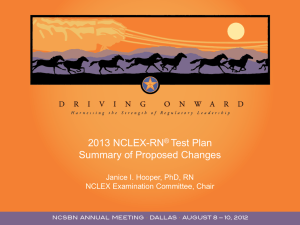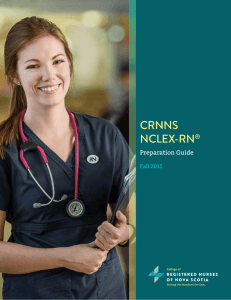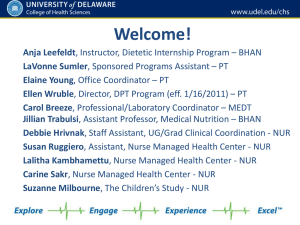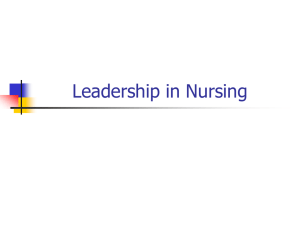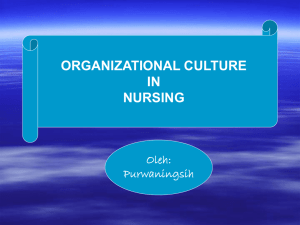Powerpoint
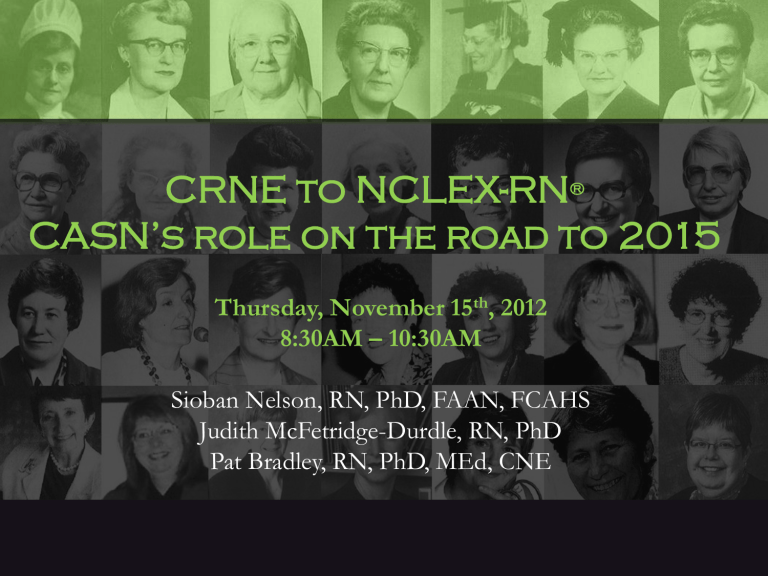
CRNE to NCLEX-RN
®
CASN’s role on the road to 2015
Thursday, November 15 th , 2012
8:30AM – 10:30AM
Sioban Nelson, RN, PhD, FAAN, FCAHS
Judith McFetridge-Durdle, RN, PhD
Pat Bradley, RN, PhD, MEd, CNE
Time Item AGENDA
8:30 – 8:40 1.0 Welcome
1.1 Advocacy Committee (November
2011 – November 2012)
8:40 – 8:50 2.0 Working Group on the New
Registration Exam
Presenter
Sioban
Nelson
Judith
McFetridge-
Durdle
Pat Bradley 8:50 – 9:30 3.0 A Comparison of the NCLEX-
RN ® and the CRNE
3.1
Transitioning to Computer
Adaptive Testing
9:30 – 9:45 4.0 Considerations for Canadian
Educators
9:45 – 10:20 5.0
Open Discussion
Cynthia Baker
10:20 – 10:30 6.0
CASN’s Next Steps
All participants
Cynthia Baker
Introduction
The Advocacy Committee, with oversight from the CASN Board of Directors, took the lead in responding to the announcement that the provincial regulators had chosen the
National Council of State Boards of
Nursing’s proposal to provide a computer adaptive registration exam to be used in
Canada.
CASN Advocacy
Committee
• Sioban Nelson, University of Toronto (Chair)
• Evelyn Kennedy, Cape Breton University
• Jacinthe Pepin, University of Montreal
• Judith McFetridge-Durdle, Memorial
University
• Linda Ferguson, University of Saskatchewan
• Stephen Bishop, Camosun College
Reaction to the
Announcement
• Position Statement on the Proposed New Entry-to-
Practice Nursing Exam, December 2011
• CASN President and Executive Director made phone calls to the provincial regulators to obtain more information about the new exam
Communication
• In April 2012 CASN sent a letter to the
Deans and Directors detailing CASN’s efforts to obtain information, and what was known at that point
• At the same time, CASN sent a letter to the
Canadian Nursing Students’ Association detailing CASN’s actions and the organizations desire to ensure a successful transition to the new exam
Communication
• Communication with the Canadian Council of Registered Nurse Regulators resulted in a meeting between Cynthia Baker and Anne
Coghlan (CCRNR President and President and CEO of the College of Nurses of
Ontario)
Actions
• Cynthia Baker attended the NCLEX
Conference in Boston in September 2012, to gather more information about the
NCLEX-RN ®
• Formation of a Working Group
Working Group on the
New Registration Exam
• Judith McFetridge-Durdle, Memorial
University (Chair)
• Evelyn Kennedy, Cape Breton University
• Julie Gibler, Victoria Island University
• Noreen Frisch, University of Victoria
• Pat Bradley, York University
• Zoraida Beekhoo, University of Toronto
Terms of Reference
• Develop an information brief to share at Council concerning key differences between the National Council
Licensure Examination (NCLEX) and the Canadian
Registered Nurses Examination (CRNE);
• Highlight areas that may affect test-taking performance of
Canadian nursing program graduates on the new registration exam for educators;
• Identify strategies that could support educators in the transition to the new exam; and,
• Keep abreast of information coming from the Canadian provincial regulatory bodies and the National State Boards of Nursing in regards to the new exam.
Actions
• The Working Group adopted the Terms of
Reference on June 26 th , 2012
• The Group met in August and October via teleconference in order to fulfill the goals outlined in the Terms of Reference
Outcomes
• Comparing the 2010-2015 CRNE and the
2013-2015 NCLEX-RN ® ; Condsiderations for Nurse Educators in Canada
• Considerations Regarding the NCLEX-
RN ® for Nurse Educators in Canada
• Companies Offering NCLEX-RN ®
Preparation Resources
Comparing
The 2010-2015 CRNE and the 2013-2015 NCLEX-RN ® :
Considerations for Nurse Educators in Canada
Exam Test Plans
• Both exams assess entry level knowledge and skills
– NCLEX-RN ® is based on a job analysis of
US new graduates with less than 6 months experience
– CRNE is based on competencies
• Based on different (although similar) legal, ethical, and regulatory documents.
NCLEX-RN
®
Item Writing
• Questions based on two textbook references (both exams)
• Potential item writers apply to the National
Council of State Boards of
Nursing/provincial regulatory bodies
NCLEX-RN
®
Item Writing
• Canadians will be able to item write for the
NCLEX-RN ®
• On the French CRNE exam 50% of items were originally written in English and translated. The other half were written in
French
Taxonomies
• NCLEX-RN ® uses Bloom’s taxonomy for coding test items: knowledge, comprehension, application and analysis
– Most items are at application and analysis levels
• CRNE tests the cognitive and affective domains
– 10% knowledge and comprehension
– 40% (minimum) application
– 40% (minimum) critical thinking
Integrated Processes
• NCLEX-RN ® questions include processes fundamental to nursing:
– Nursing process (clinical reasoning, assessment, analysis, planning, evaluation)
– Caring
– Documentation and communication
– Teaching and learning
Clinical Priorities
• The NCLEX-RN ® prioritization system for clinical practice reflects a structured hierarchy for nursing intervention priority questions that Canadian students will need to learn to be successful on the exam.
Clients
• The client in the CRNE may be a family or a community whereas it is an individual, family or group but not a community in the
NCLEX-RN ®
CRNE
Question Categories
Professional Practice
Percentage
14-24%
Nursing-Client Partnership 9-19%
Nursing Practice:
Health & Wellness
Changes in Health
21-31%
40-50%
NCLEX-RN
®
Question Categories Sub-categories
Safe and Effective
Care Environment
Management of Care
Percentage
17-23%
Safety and Infection Control 9-15%
Health Promotion and Maintenance
Psychosocial
Integrity
Physiological
Integrity
Basic Care & Comfort
6-12%
6-12%
6-12%
Pharmacological and
Parenteral Therapies
12-18%
Reduction of Risk Potential 9-15%
Physiological Adaptation 11-17%
Question Categories
• Professional Practice (CRNE) is similar to
Management of Care (NCLEX-RN ® )
– Both approximately 20% of questions
• Nurse patient relationship is 10% of CRNE questions, but is an integrated process on the NCLEX-RN ®
Question Categories
Health and Wellness (CRNE) and Health Promotion and
Maintenance NCLEX-RN ® is
- 25% of the questions in the CRNE
- 10% of the NCLEX-RN ®
• CRNE includes questions on population health, community as client, primary health care, determinants of health
• NCLEX-RN ® is more focused on individual health alterations
Question Categories
• Alterations in health
– NCLEX-RN ® focuses on pathophysiology, medical diagnoses, physical assessment, lab values, and technical aspects of care
– CRNE focuses on disease and disease management integrated into a holistic approach
NCLEX-RN
®
Examples
Safe and effective care environment
• Management of Care
– Use information technology
– Comply with state/federal regulations for reporting client conditions (abuse/neglect, gun shot wound, dog bites)
– Participate in performance improvement/QI
– Advance Directives (Durable Power of
Attorney)
NCLEX-RN
®
Examples
Safe and effective care environment
• Safety and Infection Control
– Identify which clients to recommend for discharge in a disaster situation
– Use ergonomic principles
– Participate in institution security plans (bomb threats)
NCLEX-RN
®
Examples
• Physiological integrity
– Perform irrigations (eye, ear, bladder)
– Apply pathophysiological…
– Manage care of a patient with a pacing device
• Pharmacological and parenteral therapies
– Insert, maintain, and remove IV
• Reduction of risk potential
– Evaluate invasive monitoring data (pulmonary artery pressure, intracranial pressure)
Question Formats
• Both exams pilot questions for future version of the exam (they do not count in candidate’s score).
• CRNE is a multiple choice exam (60% case based)
• NCLEX-RN ® uses various question formats other than multiple choice
– hot spots (identify area on a graphic)
– fill in the blank
– drag and drop (ranking)
– audio
– chart/exhibit
– multiple response
Hot Spot
During the admission assessment the client tells the nurse that he has a history of mitral valve stenosis. While auscultating the client’s heart sounds, to which area on the chest should the nurse apply the stethoscope to listen for mitral valve sounds? (Click the chosen location. To change, click on the new location.)
Sample supplied by HESI courtesy of Bonnie Hobbins
Drag and Drop
The nurse is performing a respiratory physical assessment on a client. In what order should the nurse assess this client? (Arrange the first item on top and the last item on the bottom.)
A. Percussion
B. Palpation
C. Inspection
D. Auscultation
Audio
The nurse is auscultating an adult client’s chest for heart sounds and hears the following sounds.
Which description best describes the client’s heart sounds?
A.Rate 160 beats/minute, rhythm - regular, tachycardia
B.Rate 110 beats/minute, rhythm - irregular, with S3 gallop
C.Rate 100 beats/minute, rhythm - regular, normal sinus rhythm
D.Rate 16 0beats/minute, rhythm - irregular, with murmur
Chart/Exhibit
INFORMATION IN CLIENT’S CHART
History and Physical Prescriptions Diagnostic Results
Diagnosis:
• Glaucoma
• CHF betaxolol (Betopic) eye drops one drop in each eye at bed time.
Electrocardiogram:
Sinus Bradycardia, rate 52
Findings:
1+ pitting edema lower extremities, bilaterally hydrochlorothiazide 25 mg
PO Daily metoprolol (Lopressor) 25 mg PO Daily
The nurse reviews the history and physical examination documented in the medical record of an elderly client during a clinic visit. Which action by the nurse is the priority?
A. Ask if the client takes over-the-counter antihistamines
B. Instruct the client to elevate both legs when sitting and lying.
C. Notify the healthcare provider of the use of Betoptic eye drops.
Sample supplied by HESI courtesy of
Bonnie Hobbins
Exam Format
• The CRNE is a paper and pen exam where candidates must answer 180-210 questions over four hours
• The NCLEX-RN ® is a computer adaptive test, where candidates answer a minimum of 75 and a maximum of 265 questions or 6 hours
(until the computer can determine with 95% confidence that the candidate has passed).
– (maximum length rule and run-out-of time
(ROOT) rule many mean failure)
CRNE Passing Standard
• Different for each version of the exam
• Pass rates have varied from 59%-68%
• The standard is set by the Examination
Committee, who consider factors such as
– the degree of difficulty of the exam
– information about preparation of new graduates
– past performance on the CRNE, and other relevant research findings
NCLEX-RN
®
Passing
Standard
• Determined by a panel of judges using the
Modified Angoff Method (i.e. judges rate how a minimally competent candidate would perform on a set of items)
• The aggregation of the ratings determines a pass mark
• This study, and other available evidence, is reviewed by policy-makers who determine the final passing standard
Pass Rates
• Pass rates on the CRNE (for first time
Canadian writers) ranges from 90-96%
• Pass rates on the NCLEX-RN ® (for first time American writers) ranges from 86-91%
• Pass rates for IENs is far lower on the
NCLEX-RN ® (27-36%) than the CRNE
(61-70%)
Re-Writing Policies
• There is a limited number of times that the
CRNE can be written. In many states, unlimited re-writes of the NCLEX-RN ® are allowed
Transitioning to
Computer Adaptive
Testing
Computer Adaptive
Testing (CAT)
Computer adaptive testing is not just a matter of being accustomed to working on a computer
Answering on a CAT
• Students cannot highlight/underline as they would on a test paper
• Students cannot change their answers
• Students cannot go back to complete questions they left blank
Computer Adaptive testing
• Reading Speed
– Participant’s reading 20-30% slower from a computer screen than a paper (i.e. Belmore,
1985)
• Reading Accuracy
– Reading accuracy and the degree of accuracy in proof-reading tasks lower for a computer based testing (Gould, 1987; Osborn & Holton, 1988)
Computer Adaptive testing
• Comprehension
Information/material presented on a computer screen resulted in poorer understanding by the participants than the information presented on the paper (Noyes & Garland, 2008)
• Time to Answer Questions
Participants took more time to answer questions on the computer (Noyes & Garland, 2008;
Bodmann & Robinson, 2004)
Computer Adaptive testing
• Student anxiety varies (Vrabel, 2004)
• When tasks are moved to the computer equivalency is often mistakenly assumed
(Noyes & Garland, 2008)
Canadian Context
• Ongoing research at Cape Breton
University
• Preliminary research shows that Canadian faculty and students will encounter challenges in transition to computer adaptive testing
CBU Research: Predictors of NCLEX Success/Failure
• Failure
– Students with a low GPA, lower education level, who are raising a family or employed
(Alameida et al., 2011; Heroff, 2009)
– ESL students (Olson, 2012)
– Course failure, lower marks in science and pathophysiology (Uyehara et al., 2007)
• Success
– Average above 80%, no course failure
CBU Research: Potential
Challenges of CAT
• Student unfamiliarity
– Linked to anxiety
• Faculty unfamiliarity
– Lack of time, expertise and resources
– Lack knowledge of resources to best help students
– Potential benefits include less time grading and more statistical feedback (Frein, 2011)
CBU Research: Computerized
Assessment Testing Products
• Important to be cognizant of the fact that these products are offered by commercial entities
• Prediction of success sometimes based on review of high-achieving students (Harding,
2010)
• Evidence from many schools of nursing in support of implementation of commercial product designed to improve NCLEX results
CBU Research: Computerized
Assessment Testing Products
• Progression Testing
– Use of purchased computer adaptive exams throughout nursing program
– Students receive ample experience
– Cost can be included in tuition or required for students to purchase
– Risk of developing false sense of security (Heroff,
2009)
• Intermittent Testing
– Specific time points (entrance, junior year, exit exam)
Computerized Testing and
NCLEX Success
• Helps identify failure risk early in education, allowing time for intervention (Heroff,
2009)
• Risk of becoming a self fulfilling prophecy
(Seldomridge and DiBartolo, 2004)
CBU Research: Clickers in the Classroom
• Use of clickers in response to multiple choice questions
• Helpful in engaging students
• Anonymous responses
• Helped faculty understand areas requiring further clarification
Considerations for
Canadian Educators
What We Know
• Canadians will be recruited as item-writers
• Test plan for the April 2013 – April 2016
NCLEX- RN ® is now available
• NCSBN/CCRNR webinars (English and
French) in December 2012; Conference in
April
What We Know
• June-August 2014 tutorials will be available for students
• 2013-2014 CCRNR will be organizing panels for Canadian educators to review questions on a weekly basis to block those
Canadian students would be unable to answer
• Transition team of regulators has been established
Still Unknown
• Process for translation
• The number/locations of testing centers that will open in Canada
• How the panel of Canadian educators will be selected
• How the questions will be selected by the panel
Open Discussion
Questions/comments for the presenters?
What additional information do you require?
How can CASN support you?
Next Steps
• Possibility of hosting a conference on the
NCLEX-RN ® for Canada educators
References
Alameida, M. D., Prive, A., Davis, H. C., Landry, L., Renwanz-Boyle, A., and Dunham, M. (2011). Predicting NCLEX-RN success in a diverse student population. Journal of Nursing Education, 50(5), 261-267.
Belmore, S. (1985). Reading computer presented text. Bulletin of the Psychonomic Society, 23, 12-14.
Bodmann, S. M. and Robinson, D. H. (2004). Speed and performance differences among computer-based and paper-pencil tests.
Educational Computing Research 31(1), 51-60.
Frein, S. (2011). Comparing in-class and out-of-class computer-based test to traditional paper-and-pencil test in introductory psychology courses. Teaching of Psychology, 38(4), 282-287. doi:10.1177/0098628311421331
Gould, J. (1987). Reading from a CRT display can be as fast as reading from paper. Human Factors: The Journal of the Human Factors
and Ergonomics Society 29(5), 497-517.
Harding, M. (2010). Predictability associated with exit examinations: A literature review. Journal of Nursing Education, 49(9), 493-
497. doi:10.3928/01484834-20100730-01
Heroff, K. (2009). Guidelines for a progression and remediation policy using standardized tests to prepare associate degree nursing students for the NCLEX-RN at a rural community college. Teaching and Learning in Nursing, 4, 79-86. doi:10.1016/j.teln.2008.12.002
Noyes, J. M. and Garland, K. J. (2008) Computer – v.s. paper-based tasks: Are they equivalent? Ergonomics 51(9), 1352- 1379
Osborne, D.J. and Holton, J. (1988). Reading from screen v.s. paper: There is no difference. International Journal of Man-Machine
Studies. 28, 1-9.
Seldomridge, L., and DiBartolo, M. (2004). Can success and failure be predicted for baccalaureate graduates on the computerized NCLEX-RN? Journal of Professional Nursing, 20(6), 361-368. doi:10.1016/j.profnurs.2004.08.005
Uyehara, J., Magnussen, L., Itano, J., and Zhang, S. (2007). Facilitating program and NCLEX-RN success in a generic BSN program. Nursing Forum, 42(1), 31-38.
Vrabel, M. (2004). Computerized versus paper-and-pencil testing methods for a nursing certification examination: A review of the literature. CIN: Computers, Informatics, Nursing 22(2), 94-98.
